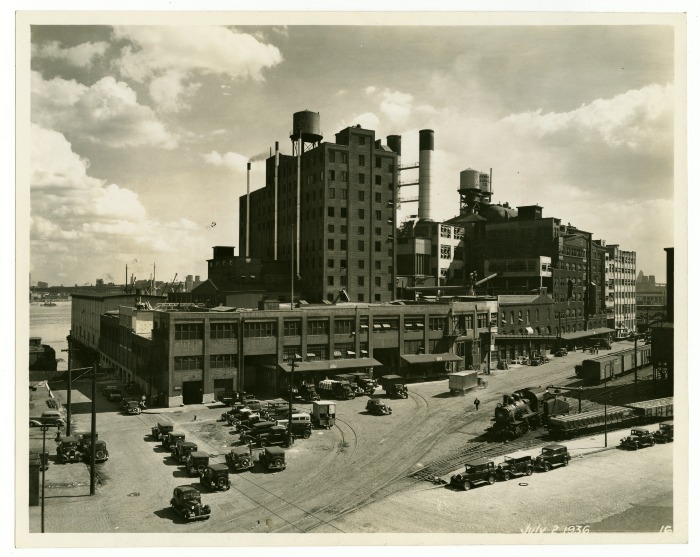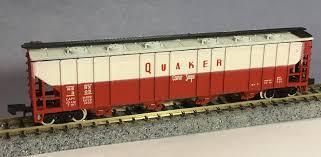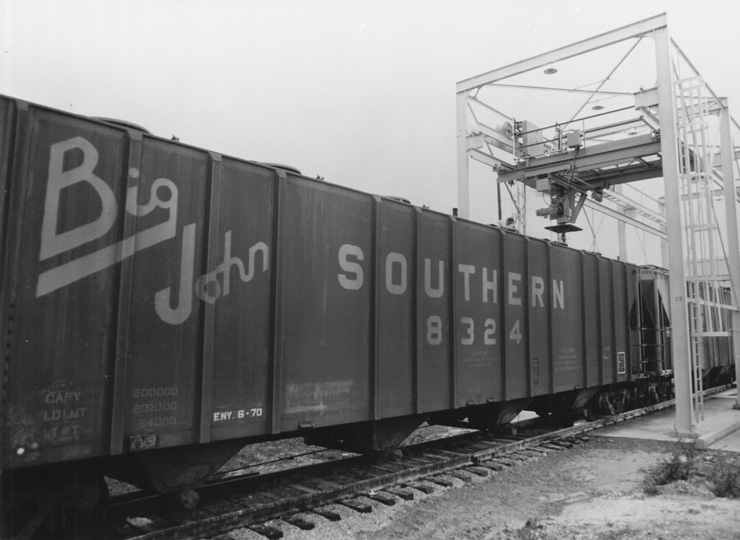Model Information: AHM contracted Roco to use the create the "jumbo hopper" in the late 1960s. The model scales to a prototypical length of about 60 feet. It was marketed in early AHM catalogs as simply a "Covered Hopper", which distinguished it from the "Center Flow Hopper" which is also made by Roco but has a distinctly different appearance. After AHM stopped ordering these from Roco, Con-Cor started releasing the same mold.
Prototype History: Right into the 1960s, grain typically was carried by 40' boxcars. They were difficult to load and to unload, but they had the huge advantage that they could be repurposed for other kinds of freight during the times when not needed for the grain rush. However, the 1960s were a tough time for the railroads. Due to competition from interstate trucking, the railroads were forced to innovate to stay competitive. This resulted in the development of the large volume covered grain hopper. The cars could handle any bulky low-density commodity that needed protection from the elements. Grain was the natural load for these cars, and Southern was a leading innovator with this type of car. They developed the 'Big John' which was quickly emulated by many other railroads.
Road Name History:  In 1900 Henry O. Havemeyer eliminated the little remaining competition to American Sugar (Domino) in the greater New York City region by consolidating the major competitive refineries in the city into the National Sugar Refining Company of New Jersey. The National Sugar Refining Co. (NSRC) was established by the consolidation of the Mollenhauer, National and New York refineries. It controlled 13 sugar mills in Cuba under a series of different corporate names and reorganized several times, making following its interests somewhat complicated.
In 1900 Henry O. Havemeyer eliminated the little remaining competition to American Sugar (Domino) in the greater New York City region by consolidating the major competitive refineries in the city into the National Sugar Refining Company of New Jersey. The National Sugar Refining Co. (NSRC) was established by the consolidation of the Mollenhauer, National and New York refineries. It controlled 13 sugar mills in Cuba under a series of different corporate names and reorganized several times, making following its interests somewhat complicated.
In May 1920 the NSRC began an expansion program with the establishment of the Cuba-Santo Domingo Sugar Development Syndicate. Although it is likely there was a relationship between the NSRC and the American Sugar Refining Co., it was never clearly stated. The Louisiana Planter and Sugar Manufacturer edition of December 20, 1924 states that negotiations were completed the week prior for the purchase of the NSRC by the American Sugar Refining Co. (Domino Sugar) at a cost of $16.5 million in cash.
Up until the end of 1947, Quaker Sugar was a brand of the Philadelphia Sugar Company. Starting in 1948, it was manufactured by the Pennsylvania Sugar Division of the NSRC, itself a division of Domino. Known to many in the neighborhood as the Sugar House, this long-standing sugar refinery closed its doors in 1984. The Pennsylvania Sugar Refining Company was the last independent producer to fight the giant Sugar Trust early in the 20th century; it later became the Pennsylvania Division of the National Sugar Refining Company in 1942.

In May 1920 the NSRC began an expansion program with the establishment of the Cuba-Santo Domingo Sugar Development Syndicate. Although it is likely there was a relationship between the NSRC and the American Sugar Refining Co., it was never clearly stated. The Louisiana Planter and Sugar Manufacturer edition of December 20, 1924 states that negotiations were completed the week prior for the purchase of the NSRC by the American Sugar Refining Co. (Domino Sugar) at a cost of $16.5 million in cash.
Up until the end of 1947, Quaker Sugar was a brand of the Philadelphia Sugar Company. Starting in 1948, it was manufactured by the Pennsylvania Sugar Division of the NSRC, itself a division of Domino. Known to many in the neighborhood as the Sugar House, this long-standing sugar refinery closed its doors in 1984. The Pennsylvania Sugar Refining Company was the last independent producer to fight the giant Sugar Trust early in the 20th century; it later became the Pennsylvania Division of the National Sugar Refining Company in 1942.
Brand/Importer Information:  AHM is the initials for Associated Hobby Manufacturers, Inc. The company was founded in 1959 as a reseller of other companies' model railroad components. Initially an HO company, they entered into N Scale in the early 1970's as an importer of products made by Roco in Austria. For N Scale products, AHM apparently contracted to use the exact same molds as were used by Roco to produce early Atlas models. They also contracted with Rivarossi to make locomotives.
AHM is the initials for Associated Hobby Manufacturers, Inc. The company was founded in 1959 as a reseller of other companies' model railroad components. Initially an HO company, they entered into N Scale in the early 1970's as an importer of products made by Roco in Austria. For N Scale products, AHM apparently contracted to use the exact same molds as were used by Roco to produce early Atlas models. They also contracted with Rivarossi to make locomotives.
When AHM went out of business IHC picked up some of their line. Also, at least one body style was taken over by Eastern Seaboard models.

When AHM went out of business IHC picked up some of their line. Also, at least one body style was taken over by Eastern Seaboard models.
Manufacturer Information:  The company was founded in 1960 by Ing. Heinz Rössler and started with a plastic Minitanks series of military vehicles. After export to the USA became successful, the model line was expanded with model trains in HO scale and the smaller N scale. TT scale was also subsequently added to the product line. The model rail product line covers many European countries including Germany, Belgium, Luxembourg, France, Spain, Austria, Italy, Switzerland, Sweden and the Netherlands, and also the USA.
The company was founded in 1960 by Ing. Heinz Rössler and started with a plastic Minitanks series of military vehicles. After export to the USA became successful, the model line was expanded with model trains in HO scale and the smaller N scale. TT scale was also subsequently added to the product line. The model rail product line covers many European countries including Germany, Belgium, Luxembourg, France, Spain, Austria, Italy, Switzerland, Sweden and the Netherlands, and also the USA.
On July 15, 2005 ROCO Modellspielwaren GmbH was declared bankrupt. From July 25 the company continues as Modelleisenbahn GmbH, but still uses the Roco brand and associated logo. On October 1, 2007, distribution of the 'Minitank' product series was assigned to the German model car manufacturer Herpa.
Since February 2008 Modelleisenbahn also owns Fleischmann, which like Roco had gone bankrupt. The two companies continue as separate brands under Modelleisenbahn GmbH, while benefiting from economies of scale through joined development projects, marketing and procurement.
From Wikipedia

On July 15, 2005 ROCO Modellspielwaren GmbH was declared bankrupt. From July 25 the company continues as Modelleisenbahn GmbH, but still uses the Roco brand and associated logo. On October 1, 2007, distribution of the 'Minitank' product series was assigned to the German model car manufacturer Herpa.
Since February 2008 Modelleisenbahn also owns Fleischmann, which like Roco had gone bankrupt. The two companies continue as separate brands under Modelleisenbahn GmbH, while benefiting from economies of scale through joined development projects, marketing and procurement.
From Wikipedia
Item created by: gdm on 2017-03-26 19:47:08. Last edited by CNW400 on 2020-06-29 12:33:54
If you see errors or missing data in this entry, please feel free to log in and edit it. Anyone with a Gmail account can log in instantly.
If you see errors or missing data in this entry, please feel free to log in and edit it. Anyone with a Gmail account can log in instantly.









